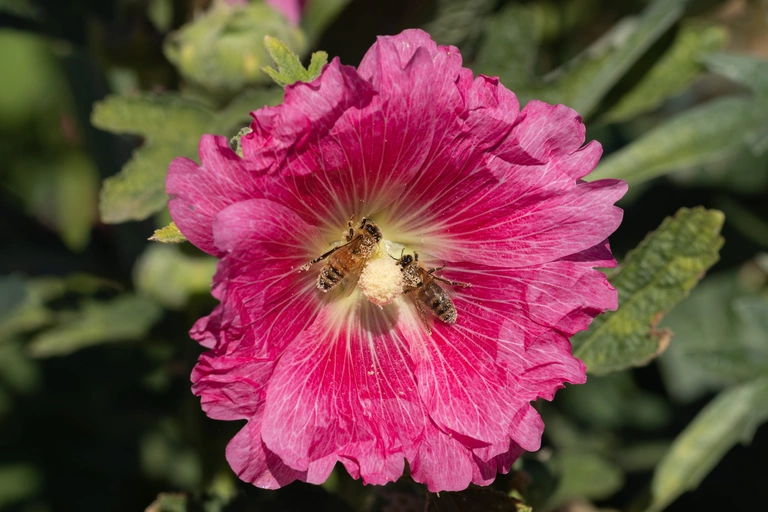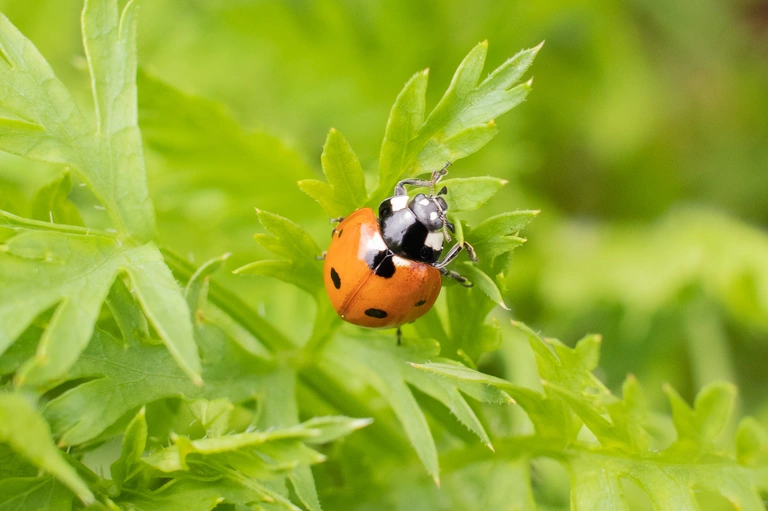Bring your garden to the next level with companion planting. Companion planting is the practice of planting different types of plants together in order to improve the health of your garden. Over the years we have used companion plants for many different purposes.

For us, the best use of companion planting has been to attract bees and other pollinators to our garden. Our favorite flowers to use as companion plants (we're in USDA zone 8b) have been snapdragons and California poppies. They always come back, year after year on their own, so now we get to enjoy them without the effort of planting them.
For the last few years, we have planted marigolds around the garden to repel pests. We have also planted sacrificial plants to help out with garden pests. Last year, Jason planted sunflowers in the garden to distract ants from damaging other plants. He discovered this solution the year before, when he saw an ant trail leading from an ant nest, in a pile of rocks, straight to the sunflowers. From now on, we will probably always have a few sunflowers growing in our garden for this purpose.
Brussels sprouts are another plant that Jason uses to distract pests. When the aphids get too dense and cover the Brussels sprouts he rinses them off with a garden hose. This year we are going to also plant Sweet alyssum near the Brussels sprouts to help us out with the aphids. We will find out if they attract the aphid-eating wasps that we've read about.
Last year we planted morning glories on our garden gate and they ended up climbing a nearby sunflower. It was so beautiful to see the color combination of the yellow sunflowers with the purple morning glories. They added a lot of interest to the entrance of the garden. This year we will be growing some white morning glory vines ('moonflower') with some 'jet black' hollyhocks. I can't wait to see that dramatic color combination!

Companion planting has been a good idea for us, in our garden, and we are focusing on it a bit more this year. We will be trying several new combinations of companion plants. We are going to be mixing marigolds in with our strawberries and beans, planting Sweet alyssum with our spinach, and planting nasturtiums with our squash and melons this year to help keep pests away. We will also be planting some oregano around the garden to repel pests.
For your garden, look for some new companion plant combinations to try out. Companion planting can help you grow healthier plants, reduce the need for pesticides, and increase the yield of your garden.
What is Companion Planting?
Some plants can be beneficial to other plants. For example, some plants can help repel pests, while others can help attract beneficial insects. By planting companion plants together you can minimize pest and disease problems and attract more pollinator insects into your garden. Companion plants can help provide structure for vining plants, provide shade for sun-sensitive plants, and also be used to shade the soil and prevent weeds from growing.
Companion Planting to Attract Beneficial Insects
Some plants can help attract pollinators into your garden. Pollinators are insects that help plants reproduce by transferring pollen from one plant to another. Pollinators include bees, butterflies, moths, and hummingbirds. By planting companion plants that attract pollinators you can increase the yield of your garden.

You can use companion plants to attract pollinators into your garden which may start your growing season earlier. This is especially great for areas with short growing seasons. To help attract bees to your strawberry plants, try planting borage nearby. The flowers will attract bees and other pollinators into your garden. Another great companion plant combination is to plant nasturtiums with your melons. The nasturtiums will attract bees, which will help pollinate your melons.
Certain types of wasps are also beneficial to your garden. They help control pests by eating the larvae of insects that can damage your plants. To attract wasps into your garden, try planting yarrow, fennel, and nasturtiums.

Ladybugs eat aphids, which can damage your plants. To attract ladybugs into your garden, try planting dill. A good companion plant combination is to plant dill with your Brussels sprouts. The dill will attract ladybugs, which will help control aphids on your Brussels sprouts.
Other aphid-eating insects, like hoverflies, can be attracted to plants like alyssum. Alyssum is a great companion plant for lettuce. The alyssum will attract hoverflies, which will help control aphids on your lettuce plants.
Companion Planting to Repel Pests and Diseases
Another good companion plant for lettuce is garlic which can help to repel insects. Garlic is a great companion plant for potatoes too. Plant garlic with many of your plants to help repel onion flies, ermine moths, and Japanese beetles. By planting companion plants that repel pests you can reduce the need for pesticides in your garden.
Many plants with a strong scent can be used as companions for flowering plants. Rosemary, oregano, basil, chives, onions, and garlic can all help repel insects as well. Planting garlic near your roses can help repel aphids. Chrysanthemums, marigolds, and petunias are also great at repelling insects. Planting a row of mums around your vegetable garden can help repel insects. Mums are a really good companion plant for cabbage since they help repel insects. Another great companion plant combination is to plant basil near tomatoes. Basil will help to deter moths that lay tomato hornworms and also army worms that lay eggs. Basil also attracts bees to pollinate your tomato plants.
For plants that are susceptible to the same diseases (like eggplants, peppers, and tomatoes) it is a good idea to spread the plants around amongst other types of plants instead of planting them all together in a group. This way diseases (blight and verticillium wilt) cannot spread through the whole group. It is also a good idea to plant several different varieties for the same reason.
Sacrificial Plants
Some plants can be used as sacrificial plants. These plants are planted near your garden to attract pests away from your garden. Brussels sprouts can be planted to attract aphids. Sunflowers are great for attracting ants. Nasturtiums can be planted with broccoli and cabbage in order to distract caterpillars.
Hopefully, by planting some of these sacrificial plants, you can protect the plants that you really value in your garden. The sacrificial plants should provide enough food for the pest that you are targeting. That way they will leave the rest of your garden alone.
By planting legumes in your garden you can help improve the health of your soil. Legumes, such as peas and beans, can help add nitrogen to your soil. Beans and corn are a great companion plant combination for your vegetable garden. Beans provide extra nitrogen for your corn plants and the corn provides structure for the beans to grow on.

Companion plants can be used to provide shade for other plants. So try planting peas or beans near your spinach to provide shade for your spinach plants. You can also plant dill with your lettuce plants to provide some shade.
Other companion plants can help shade the soil and prevent weeds from growing. Spinach can be planted around your corn plants to help shade the roots. Another idea is to plant nasturtiums with your squash so they can help shade the soil and prevent weeds from growing. The nasturtiums will also attract pollinators for your squash plants.
Some companion plants can be used to help provide support for vining plants. For example, sunflowers or hollyhocks can be planted with morning glory to provide them with some structure to grow on.
Companion Planting Chart
There are so many different types of companion plants that you can use in your garden and many different reasons for using them. When you are planning your garden, choose your companion plant pair based on the purpose that you have for using companion plants.
Are you trying to attract pollinators, repel pests and diseases, share nutrients, provide shade, or provide support for nearby plants? After you decide on the reasons for using companion plants you can choose the plants that will fulfill that purpose. The following list is just a small sample of the many companion plant combinations that you can try in your garden. Let us know which combinations are your favorites in the comments.
Attracting pollinators and beneficial insects:
- nasturtiums - for melons, cucumbers, squash, and beans
- borage - for strawberries
- zinnias - for tomatoes, beans, and squash
- parsley - for potatoes and tomatoes
- sweet alyssum - for peas, lettuce, and broccoli
- calendula - for peas
- dill - for Brussels sprouts, broccoli, kale, and squash
Repelling pests and diseases:
- oregano, rosemary, sage, onion, garlic, marigolds, petunias, and chrysanthemums are natural insect repellants
- garlic - for lettuce and potatoes
- oregano - for peppers
- basil - for tomatoes, kale, and potatoes
- chrysanthemums - for cabbage
- chives - for carrots
- marigolds - for eggplant, onions, potatoes, and peppers
- nasturtiums - for broccoli and cabbage
- calendula - for kale and squash
Sharing nutrients or space:
- garlic, carrot, onion, and beets - to share nutrients and repel pests and diseases
- beans with corn - to provide nitrogen
- beet, carrot, and radish - Radishes are ready first, so as you harvest them you end up making more space for the carrots and beets.
- lettuce with melon or winter squash - Lettuce will be done by the time the melons or winter squash need the space.
Providing shade or vine support:
- sweet alyssum for broccoli (shades soil)
- spinach with corn (shades soil)
- beans or peas can provide shade for spinach
- dill can provide some shade for lettuce
- corn with green beans (vine support)
- hollyhocks or sunflowers with morning glories (vine support)
As a sacrificial plant:
- Use sunflowers to distract ants from other plants in your garden.
- Brussels sprouts can distract aphids, so they leave your other plants alone.
- Use radishes to distract flea beetles from melons.
- Nasturtiums can distract caterpillars from broccoli and cabbage.
How to Use Companion Plants
To start using companion plants in your garden, decide which purpose you want your companion plants to serve. Do you want to attract beneficial insects? Do you want to repel pests? Do you want to improve the health of your soil? Once you have decided what you want your companion plants to do, you can choose which plants to grow together.
The next time you are at your local nursery shopping for plants, try to think about using them as companions in your garden.







